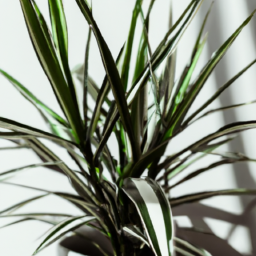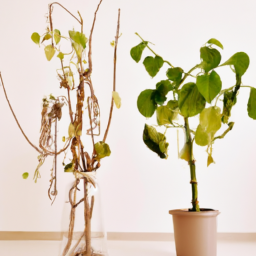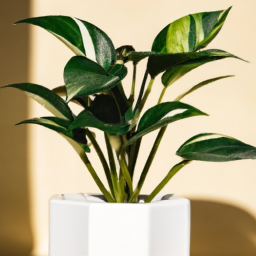
Are you looking to add some greenery to your indoor space but not sure whether to go for real or fake plants? The debate between Indoor Plants Real vs Fake has been ongoing for quite some time now. In this blog post, we will explore the pros and cons of both options to help you make an informed decision on which type of indoor plants is best for you. Let’s dive in and discover the benefits and drawbacks of each choice.
Benefits of Indoor Plants: Real vs Fake
Real Indoor Plants
When it comes to indoor plants, there are numerous benefits to having real plants in your home. Real indoor plants not only add a touch of nature to your indoor space but also provide numerous health benefits. One of the main benefits of real indoor plants is their ability to purify the air. Plants absorb carbon dioxide and release oxygen through the process of photosynthesis, helping to improve the air quality in your home. This can help reduce the symptoms of allergies and asthma, as well as improve overall respiratory health.
In addition to improving air quality, real indoor plants can also help reduce stress and improve mental health. Studies have shown that being around plants can help lower blood pressure, reduce anxiety, and improve overall mood. The act of caring for plants can also be therapeutic, providing a sense of purpose and accomplishment. Real indoor plants can also help increase productivity and creativity, making them a great addition to home offices or creative spaces.
Another benefit of real indoor plants is their ability to boost humidity levels in your home. Plants release moisture through a process called transpiration, which can help combat dry indoor air and improve overall comfort. This can be especially beneficial during the winter months when indoor heating can cause the air to become dry and uncomfortable. Overall, real indoor plants offer a wide range of benefits for both physical and mental health.
Fake Indoor Plants
While real indoor plants offer numerous benefits, fake indoor plants also have their advantages. One of the main benefits of fake indoor plants is their low maintenance requirements. Fake plants do not require watering, sunlight, or pruning, making them a great option for those with busy schedules or a lack of natural light in their home. Fake plants are also a good option for those with allergies to pollen or mold, as they do not produce any allergens.
Another benefit of fake indoor plants is their durability. Fake plants do not require any special care or attention and will not wilt or die if neglected. This makes them a great option for those who do not have a green thumb or who struggle to keep real plants alive. Fake plants are also a good option for those who travel frequently or spend extended periods away from home, as they will not require any care while you are away.
However, fake indoor plants do not offer the same air purifying benefits as real plants. Fake plants do not absorb carbon dioxide or release oxygen, so they will not improve air quality in your home. Fake plants also do not offer the same mental health benefits as real plants, as they do not provide the same sense of connection to nature. While fake indoor plants may be low maintenance and durable, they do not offer the same health benefits as real plants.
Overall, both real and fake indoor plants have their own set of benefits. Real plants offer air purifying properties, mental health benefits, and increased humidity levels, while fake plants offer low maintenance requirements and durability. When choosing between real and fake indoor plants, consider your lifestyle, level of commitment to plant care, and desired benefits to determine which option is best for you.

Maintenance Differences Between Real and Fake Indoor Plants
Real Indoor Plants
When it comes to maintaining real indoor plants, there are a few key factors to keep in mind. First and foremost, real plants require regular watering to thrive. The frequency of watering will depend on the type of plant, the size of the pot, and the environment in which it is placed. It’s important to check the soil moisture levels regularly and adjust your watering schedule accordingly.
In addition to watering, real indoor plants also require adequate sunlight to photosynthesize and grow. Different plants have different light requirements, so it’s crucial to place your plants in a location where they will receive the appropriate amount of light. Some plants thrive in bright, indirect light, while others prefer low light conditions. Be sure to research the specific light needs of your plants to ensure they stay healthy.
Another aspect of maintaining real indoor plants is pruning and grooming. Regularly trimming dead or yellowing leaves, as well as removing any debris or dust from the plant’s foliage, can help promote healthy growth and prevent pests and diseases. It’s also important to repot your plants when they outgrow their containers to provide them with fresh soil and room to grow.
Fake Indoor Plants
Maintaining fake indoor plants is generally much simpler and less time-consuming than caring for real plants. One of the main advantages of fake plants is that they require no watering or sunlight, making them a great option for those with busy schedules or low-light environments. Simply dusting or wiping down the foliage occasionally is usually all that is needed to keep fake plants looking their best.
Another benefit of fake indoor plants is that they are not susceptible to pests or diseases, eliminating the need for pesticides or other treatments. This can save time and money in the long run, as you won’t have to worry about monitoring your plants for signs of infestation or illness.
While fake indoor plants don’t require pruning or repotting like real plants, they may still benefit from occasional grooming to remove dust and maintain their appearance. Depending on the material of the plant, you may be able to gently wash the foliage with water or a mild soap solution to keep it looking fresh and vibrant.
Overall, the maintenance differences between real and fake indoor plants are significant. Real plants require more time and attention to thrive, while fake plants offer a low-maintenance alternative that can still add greenery and beauty to your space. Ultimately, the choice between real and fake plants will depend on your lifestyle, preferences, and the amount of time you are willing to dedicate to plant care.

Environmental Impact of Choosing Real or Fake Indoor Plants
Real Indoor Plants
When it comes to choosing between real and fake indoor plants, one of the most important factors to consider is the environmental impact. Real indoor plants have a number of benefits for the environment. They help improve indoor air quality by absorbing carbon dioxide and releasing oxygen during photosynthesis. This can help reduce the levels of harmful pollutants in the air, such as formaldehyde and benzene.
In addition, real indoor plants can help regulate humidity levels in your home, which can be beneficial for both your health and the health of your furniture. By releasing moisture into the air through a process called transpiration, real plants can help prevent dry skin, respiratory issues, and static electricity buildup.
Furthermore, real indoor plants can have a positive impact on the environment outside of your home as well. They can help reduce the urban heat island effect by providing shade and cooling the air through evapotranspiration. Real plants also provide habitats for beneficial insects and wildlife, which can help support biodiversity in urban areas.
Overall, choosing real indoor plants can have a positive impact on both your indoor environment and the environment at large. By incorporating real plants into your home, you can help improve air quality, regulate humidity levels, and support biodiversity in your community.
Fake Indoor Plants
While fake indoor plants may seem like a low-maintenance and convenient option, they come with their own set of environmental impacts. Most fake indoor plants are made from plastic materials, which are derived from non-renewable resources such as petroleum. The production of plastic plants can contribute to greenhouse gas emissions and pollution, both during the manufacturing process and when the plants eventually end up in landfills.
In addition, fake indoor plants do not provide the same benefits for indoor air quality as real plants. They do not absorb carbon dioxide or release oxygen, and they do not help regulate humidity levels in your home. Fake plants also do not support biodiversity or provide habitats for wildlife, as they are not living organisms.
Furthermore, fake indoor plants can be difficult to recycle or dispose of responsibly. Because they are made from plastic materials, they may not break down easily in landfills and can contribute to plastic pollution in the environment. In contrast, real plants are biodegradable and can be composted at the end of their life cycle.
Overall, choosing fake indoor plants can have a negative impact on the environment. While they may require less maintenance than real plants, fake plants do not provide the same environmental benefits and can contribute to pollution and waste. If you are looking to minimize your environmental impact, opting for real indoor plants is the more sustainable choice.
Conclusion
In conclusion, the choice between real and fake indoor plants can have a significant impact on the environment. Real indoor plants offer a range of benefits, including improving air quality, regulating humidity levels, and supporting biodiversity. On the other hand, fake indoor plants are made from non-renewable resources, do not provide the same environmental benefits, and can contribute to pollution and waste.
If you are looking to reduce your environmental impact and create a healthier indoor environment, choosing real indoor plants is the more sustainable option. By incorporating real plants into your home, you can enjoy the aesthetic and health benefits of indoor greenery while also supporting the environment. Consider the environmental impact of your indoor plant choices and make a decision that aligns with your values and sustainability goals.
Crisp Recap
Are you looking to add some greenery to your home but can’t decide between real or fake indoor plants? Both options have their pros and cons, so it’s important to weigh them carefully before making a decision. Real plants offer a natural beauty and can improve indoor air quality, but they require more maintenance and can be finicky when it comes to light and water. On the other hand, fake plants are low maintenance and can look just as good as the real thing, but they don’t offer the same benefits to your health and well-being.
When choosing between real and fake indoor plants, consider your lifestyle and how much time you’re willing to dedicate to plant care. If you have a green thumb and enjoy the process of caring for plants, real plants might be the way to go. However, if you have a busy schedule or lack a green thumb, fake plants can provide a low-maintenance alternative that still adds a touch of nature to your space. Ultimately, the choice between real and fake plants comes down to personal preference and what works best for your lifestyle and home environment.
Here are some FAQs you’d be interested in:
Q1. What are the benefits of having real indoor plants?
A1. Real indoor plants not only add beauty to your space but also help improve air quality by releasing oxygen and absorbing carbon dioxide. They can also boost your mood and reduce stress levels.
Q2. What are the advantages of having fake indoor plants?
A2. Fake indoor plants require minimal maintenance and are a great option for those who don’t have a green thumb or time to care for real plants. They are also a good choice for spaces with low light or where real plants may not thrive.
Q3. How can I tell if an indoor plant is real or fake?
A3. To determine if an indoor plant is real or fake, you can look closely at the leaves and touch them. Real plants will have variations in color, texture, and imperfections, while fake plants may look too perfect and uniform.
Q4. Do real indoor plants require more care than fake plants?
A4. Yes, real indoor plants require regular watering, proper sunlight, and occasional pruning to thrive. Fake plants, on the other hand, only need occasional dusting and cleaning to maintain their appearance.
Q5. Which is more cost-effective in the long run, real or fake indoor plants?
A5. While fake indoor plants may have a higher upfront cost, real indoor plants can be more cost-effective in the long run as they can last for years with proper care and propagation. Fake plants may need to be replaced over time due to wear and tear.
Dr. Olivia Green is a botanist with over two decades of experience in indoor plant cultivation. She holds a Ph.D. in Plant Biology and has dedicated her career to researching plant behavior in controlled environments. Dr. Green is passionate about helping plant enthusiasts master the art of indoor gardening through her extensive knowledge and practical insights.


